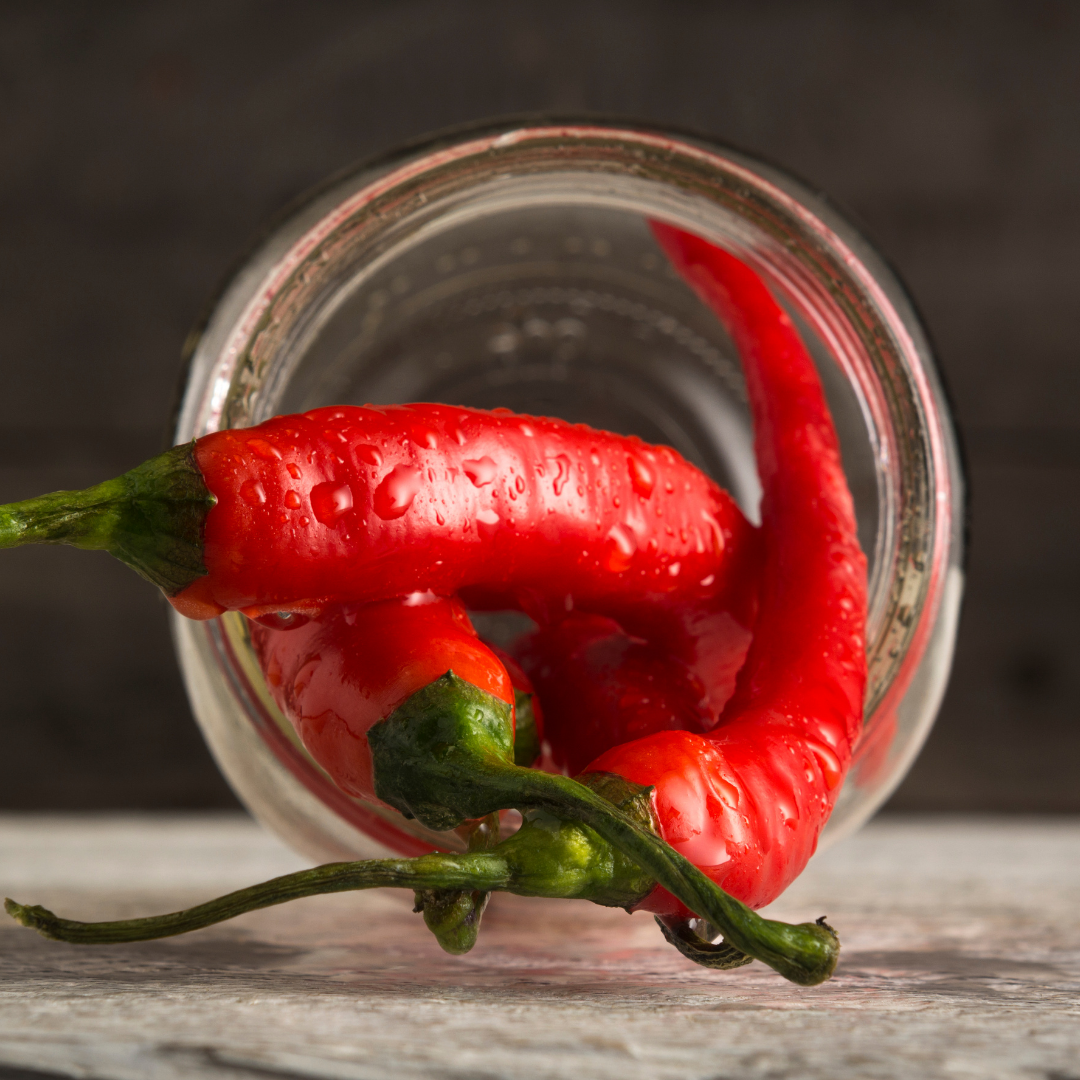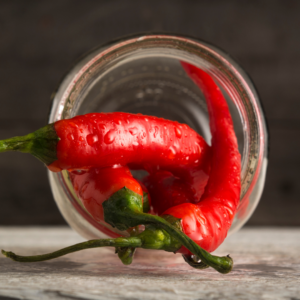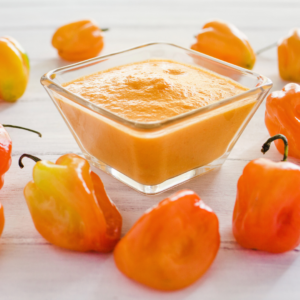Table of Contents
Hands down, hot sauce is the most versatile condiment on the face of planet Earth. Now, some people, in an attempt to spice up their food, spend $5+ on hot sauce without knowing that they can make the cheaper and better sauce at home. But then there are some people like us who don’t only enjoy eating, but also cooking – from scratch! So, do you want to make the hot sauce at home that doesn’t taste like a bottle of vinegar? Then read on to discover how to make the lacto fermented hot sauce, the hottest new craze in the kitchen. Let’s get started!
What are Lacto Fermented Peppers?
Lacto fermented peppers are peppers that undergo the lacto-fermentation process, where bacteria break down the natural sugar in foods to create lactic acid. Laco fermentation has nothing to do with milk! Instead, the word ‘Lacto’ comes from a preservative lactic acid. Lactic acid is the key ingredient for pickling and fermenting ordinary peppers into hot sauce (i.e. think Kimchi or Sauerkraut). For all the health-conscious beings out there, the bacteria that help create lactic acid is ‘good’ bacteria like Lactobacilli, which is amazing for gut health.
- Flashbang Hot Sauce, An Explosion Heatwave!
- Taco Bell Diablo Scoville, How Hot Is It?
- What’s the Scoville Measure for Wasabi?
Peppers are must-have condiments year round. No matter what you are making, peppers lend their delicious flavors to everything, and they taste better when fermented!
Editor’s note: As you read, you may notice slight differences in the fermentation process, based on the recipe. But always keep in mind, the actual lacto-fermentation process doesn’t change; it still takes about a month to do it. It’s only the process and ingredients that vary. So, let’s dive in!
How to Make Fermented Hot Peppers
You can easily make fermented hot peppers at home by following these steps:
The Lacto Fermentation Process:
Step one is to prepare the ingredients to ferment. Next, you flavor them up. Lastly, you actually ferment them.
Ingredients to Ferment
- Hot peppers – 200 gm
- Fresh, drinkable water – 400gm
- Lactic fermentation juice (organic and raw sauerkraut); a splash
- Sea salt – 18 gm
Preparation to Ferment
- Sterilize your fermentation equipment, including the jar, lid, and weights.
- Wash your pepper, remove its stems, and cut julienne or slice.
- Add all the ingredients in your jar, cover the lid and shake it like crazy for two minutes.
- Remove the lid of your jar and place your fermentation weight in the jar to submerge the peppers in the liquid.
- Ferment for about a month.
Ingredients to Flavor them Up
- Sweet peppers – 1 kg
- Fresh, drinkable water – 1 liter
- Sea salt – 45 gm
- Seasoning – cumin, cayenne, peeled garlic, sliced onion, cilantro/parsley, etc.
Fermenting Your Hot Peppers
- Dissolve 45gm of salt in 1 liter of filtered water and set that aside.
- Wash your peppers, remove the stems, and cut the peppers into strips or cubes.
- For extra flavor, add a teaspoon of seasonings to the bottom of your jar. Fill it with peppers until it is about halfway full. Add in a little more seasonings. Fill the leftover space in the mason jar with chopped peppers, leaving about one to two inches of room.
- Pour the saltwater over the peppers and seasonings until they are completely submerged.
- To keep the peppers immersed in the brine, weigh them down if required. Cover the jar with an airtight lid.
- Culture at room temperature (preferably 60-70F or 15C) until you receive your desired flavor. If you’re using a tight lid, burp once a day to relieve the pressure.
- Cover the jar securely and keep it in the refrigerator when the peppers are done.
Fermented Hot Peppers Go Great With Anything!
Lacto fermented peppers go well with any raw salad that includes bell peppers. You can make a taco salad, a fresh salsa, or even a sour gazpacho with them. Moreover, fermented hot peppers are great in a grain or bean salad. You can throw them to a bowl of beans and even top cooked Italian or other sausages with them. And, if you’re a true pepper fan, you can eat them directly from the jar. Here is what you will have to do to add that salty, tangy, savory flavor.
But the best has yet to come – that’s lacto fermented hot sauce and fermented habanero hot sauce!
Lacto Fermented Hot Sauce
Lacto-fermented hot sauce is basically the result of putting your peppers through the lacto-fermentation process.
How to Make Lacto-Fermented Hot Sauce?
There are two basic requirements to making the best Lacto-fermented hot sauce: patience and the correct peppers. Now, the ‘patience’ part is pretty self-explanatory, but the jalapenos and Serrano you find at the supermarket aren’t the ‘correct peppers.’ Why is that so?
Check out the origins of fermented pepper hot sauce.
Use Fresh Organic Hot Peppers
Organic, fresh-from-the-ground peppers covered with natural bacteria are not in the grocery store’s best interests. They degrade faster and cost more this way, so they’re usually waxed instead.
The best option is to enter your nearest farmer’s market to choose peppers for your Lacto-fermented hot sauce. Local peppers are preferred since they do not travel as far, and the beneficial bacteria do not perish in transportation. However, if you don’t have access to a farmers’ market, your best bet is to produce your own peppers.
Okay, enough talking; let’s jump on the recipe to make the best Lacto-fermented hot sauce you have ever tasted!
Ingredients
- Fresh harvested, organic hot peppers – 1kg
- Fresh, drinkable water – 2 liter
- Sea salt; 3% of the total quantity of peppers and water
- Lactic fermentation juice (organic and raw sauerkraut) if not already fermented
Equipment
Fermentation crock. If you don’t have one readily available, you can use a wide-mouthed jar. But you will need to find weights that fit inside the jar to keep the peppers submerged in the brine.
Preparation
- Wash your peppers and remove their stems. Fill your crock or jar 3/4 full with the washed peppers.
- Pour the water over the peppers while pressing them with one clean hand until the peppers are fully submerged in the liquid. Ensure you’re not using treated water (the chlorine doesn’t help much with fermentation).
- Calculate 3% of the entire mass (in this case, 90g), measure, and add that amount of sea salt to the fermentation. It will ultimately reach equilibrium, but feel free to stir it up a little with your hand until it does.
- Add a dab of raw-fermented brine (from sauerkraut or a previous batch of hot sauce). This will act as a starter and ensure the success of your fermentation. You can omit fermentation juice if you don’t have it at home; if your peppers are of good quality, they should contain a sufficient quantity of lactobacilli to start up the process.
- Use the weights in your crock to uniformly press the (nearly) submerged peppers down. The peppers should be completely submerged in brine after 24 hours. The salt and compression from the weights tear down their structure a little, allowing them to release any water they were holding, increasing the amount of brine produced.
- Cover the lid and leave it at room temperature for about a month to get a nice, acidic Lacto-fermented hot sauce. You can achieve a satisfactory result in less time, but the longer it ferments, the sourer it becomes. Check it once a week, scraping any white molds that appear on the brine’s surface with a spoon.
- Puree with a blender until smooth, then strain if desired. You can save the leftovers from the straining process and dehydrate and ground them into a delectable fermented chili powder.
Fermented Habanero Hot Sauce
If you are up for a spicy kick to your salads and nachos, you have to try this fermented habanero hot sauce. This sauce is made from the hottest peppers among the culinary peppers; this sauce is fruity, floral, sweet, and bursting with spice.
How to Make Fermented Habanero Hot Sauce
Here are the things you will need to make fermented habanero hot sauce at home:
Ingredients for Fermented Habanero Hot Sauce
- Habanero peppers – 1/2 pound
- Roughly chopped carrots – 3 medium-sized
- Roughly chopped onion – 3 medium-sized
- Garlic – 2 cloves
- Olive oil – 1 teaspoon
- White vinegar – 1 cup
- Salt – 2 tablespoons
Preparation of Fermented Habanero Hot Sauce
- Remove the stalks from the habanero peppers and roughly chop them. Place them in a blender and puree until smooth.
- Take some mason jars, boil (sterilize) them, and cool them for ten minutes to kill the bacteria. Make a pepper mash using a pepper-to-salt ratio of 30:1. Store the mash in Mason jars for a month of fermentation.
- Preheat the oven to 200 degrees C (4000 degrees Fahrenheit). Drizzle oil over your carrots, onions, and garlic and place them in a foil pack on the baking sheet.
- Roast the veggies until tender, about 40 minutes in a preheated oven. Puree the mixture in a food processor.
- In a mixing dish, combine the habanero mash, veggie mix, and vinegar; set aside for at least one week or a month if you can to allow flavors to blend.
Have you tried Zombie Apocalypse or Flashbang Hot Sauce yet? Dive in on them for some nice heat!
Fermented Hot Peppers
If you find whole peppers a little too hot to handle, you can always ferment them. Fermenting hot peppers makes them milder and more flavorful. Moreover, fermented hot peppers are excellent to help with digestive issues and, needless to say, they make your food taste incredible.
Conclusion
A good, homemade Lacto-fermented hot sauce elevates many dishes by adding flavor, heat, and zing. It may turn drab food into fab, and it can even raise a dish on the verge of excellence into the Monica Geller category.
And there, some people thought the hot sauce was nothing more than something they slather on a taco at their favorite Mexican joints. So, if you belong to the list of persons who aren’t taking advantage of this incredible sauce to its full potential, try these popular and not-so-common methods of making fermented and Lacto-fermented sauces and peppers to spice up your dinner!

This is Merve from the JarKitchen Team. I am a freelance content specialist, and I like cooking different recipes in my free time. During the pandemic, I have had plenty of time to practice my cooking skills and cooking turned out to be a hobby for me.









